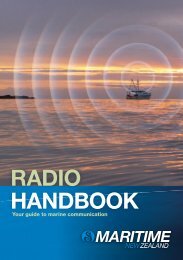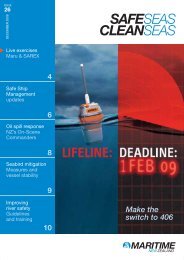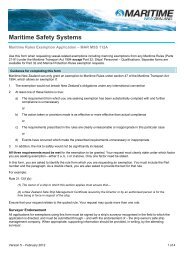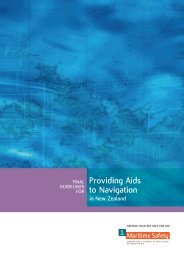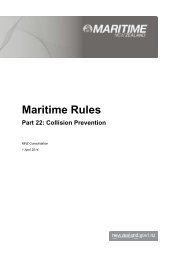Create successful ePaper yourself
Turn your PDF publications into a flip-book with our unique Google optimized e-Paper software.
Don’t take chanceswhen kayaking!Gas detectors canprevent explosionsA tourist drowned after hisopen cockpit kayak capsizedon a high-flowing river.Although he (kayaker 1) was kayakingwhat was normally a class I to II (easyto moderate) river with a very experiencedfemale companion (kayaker2), the pair had several times that dayconsidered abandoning the trip due tohigh water flow.They had borrowed two kayaks fromthe owners of holiday accommodationwhere they were staying, and had alsoconsulted several local people as to thenature and flow of the river before settingout. The owners had recommended thatthey stay on the lake and not to go onthe river, as the water could be very swift.At the time of the accident the river flowwas 650 cubic metres (650 000 litres)per second.The pair had been able to borrow onlyone life jacket and kayaker 2 wore this,as she was the only one who fitted it.They had tied a plastic/vinyl buoy to eachkayak, using approximately 16 metres oforange plastic rope. The purpose of thiswas that should one of them capsize, theother could throw their buoy to assist theswimmer in the water.As they approached a notorious spoton the river, about which they had beenwarned, kayaker 1 paddled across to aneddy on one side of the river to assesswhat lay ahead. The high river level meant1. Although a life jacket may not haveprevented this death, it is not wise tokayak without one. Particularly when theriver flow is swift and there are heavilywooded sides, as this removes the optionof a swimmer floating in the middle ofthe river and waiting for an unwoodedsection of a bank to swim ashore.2. The kayaker who died had littleexperience, and neither kayaker hadany previous experience of the riverconcerned. The water of the lake-fedriver would have been clear at all times,so it would not have been immediatelyobvious that it was in very high flow toKayaker 2’s kayak.a lot of water was flowing through thetrees on the riverbank. Kayaker 2 paddledinto some slow moving current belowkayaker 1’s eddy. In order to steady thekayak, kayaker 2 grabbed hold of sometrees and in doing so capsized and fellout of the kayak. She was quickly sweptdownstream. Kayaker 1 threw her theplastic/vinyl buoy that was attached tohis kayak, and in doing so also capsized.Kayaker 2 was swept by the weightof water into a rata tree protruding fromthe bank. She managed to free herselffrom the rope that was attached to herkayak, resurface and climb onto the tree.She saw both kayaks trapped on thebranches of the rata tree but could notsee kayaker 1. She then struggled uponto the riverbank, and ran downstreamsearching unsuccessfully for kayaker 1.She met a tourist who called 111,and both women then returned to theaccident site. Returning to the tree shehad been caught on, kayaker 2 saw thethe pair had several times that day consideredabandoning the trip due to high water flow.someone who did not know it well.3. The pair did seek out informationabout the river, but none of it was goodquality advice that related specificallyto kayaking.4. Both kayakers struggled with theropes they had tied on as rescue lines.Rope and rivers are a potentially dangerousmix. Although throw bags can beuseful in rescuing people and equipmenton a river, they should not be carriedwithout a knife to allow them to be cutaway if necessary.5. The open cockpit kayaks that wereused on this trip have wide flat hulls thatcoat jacket kayaker 1 had been wearingsubmerged beneath the branches of thetree. She managed to venture along oneof the branches far enough to be able topoke the jacket with her foot. It was atthis stage she realised her companionwas still in the jacket and that he wastrapped under the water.Due to the fast flowing water, andthe flimsy structure of the tree, it was notpossible to retrieve the body of kayaker 1.His body was later recovered with thethe rata tree (Note Kayaker 2’s kayak still pinned).assistance of a jet boat. The rescue ropethat had been attached to the kayak wasfound around his neck. The driver of thejet boat estimated the rate of the riverflow at this time to be about 25-30 knots.View the full report online at:www.maritimenz.govt.nzLookout!Pointsare most ideally suited for family fun oncalm water.6. There was no neoprene cockpit cover(spray skirt) on either of the two kayaks.These are worn by the paddler and aresecured around the rim of the cockpit tokeep out any water.7. <strong>Maritime</strong> <strong>New</strong> <strong>Zealand</strong> has recommendedthat managers of all Departmentof Conservation visitor centres seek inputfrom local kayaking experts to formulateguidelines to help staff give appropriateadvice regarding kayaking local rivers.A recreational skipper washospitalised for six weekswith severe burns afterthe stove on his 8.4 metrefibreglass yacht exploded.On the day of the accident, theskipper had replaced a gas bottle and itsregulator after noticing on an earlier tripthat the stove was not working properly.The skipper soap-tested the regulatorsuccessfully and found the pressure wasnow working well, with no apparent gasleaks. He ignited the two burner stoveand then turned off one of the burners,leaving the other running to further testthe gas pressure and then busied himselfin the saloon. Minutes later, there was aloud explosion in the starboard quarterberth next to the stove. The skipper burstout of the quarter berth with seriousburns over his lower body. Realising theyacht was on fire, the skipper, quicklyreturned and attempted to fight the fireMinutes later, therewas a loud explosionin the starboardquarter berth nextto the stove.with the help of other people nearby. Onlythen did the skipper realise the extent ofhis injuries and an ambulance was called.Accident investigators found thePVC constructed gas line between thegas bottle, located in the aft cockpitlocker and the stove in the quarter berthwas perforated with what appeared to bea number of drill holes. These drill holeswere considered to be the cause of theFire Damage to Topsides.initial poor performance that theskipper had tried to rectify by replacingthe gas regulator.Before the accident, when the skipperwas overseas, engineers had replacedthe yacht’s motor and installed a newelectric loom. This had required a numberof holes to be drilled in the yacht’s internalbulkheads. The run of the loom cablingwas next to the gas line and several drillholes in the bulkheads were found tobe near to the perforations in the gasline. The skipper had not conducted anydrilling during his ownership of the yacht.Damage to the yacht was extensive,both structurally from the force of the1. The yacht’s gas line had not beentested and there was no gas detectoron board, in breach of the Yachting<strong>New</strong> <strong>Zealand</strong> Safety Regulations. Pressuretesting would certainly have exposedthe leak and may have preventedthe accident.2. LPG is heavier than air and will settlein lower areas of a vessel. In concentrationsof one part per 70 to air, it willexplode when ignited. A gas detectorwith a remote sensor unit is inexpensive,and can automatically shut off any electricallyoperated gas solenoid valve.3. The use of Poly Vinyl Chloride(PVC) for the gas line is a breach of<strong>New</strong> <strong>Zealand</strong> Standards. Plastic hardenswith time and can crack and in this caseexplosion and due to the severe effectsof the fire. The yacht, which was insuredfor $47,000, was declared a constructivetotal loss.The skipper suffered extensive burnsto 25% of his body. Most of the burnswere to his legs, but his arms and facewere also affected. He has undergoneseveral skin graft operations and continuesto suffer pain from his injuries.View the full report online at:www.maritimenz.govt.nzLookout!Pointsbe inadvertently perforated.4. It is common for gas explosion victimsto not immediately realise the extent oftheir injuries. It is crucial that burns beimmersed in water immediately to preventdeep tissue damage.14 LOOKOUT! JULY <strong>2006</strong>LOOKOUT! JULY <strong>2006</strong> 15





